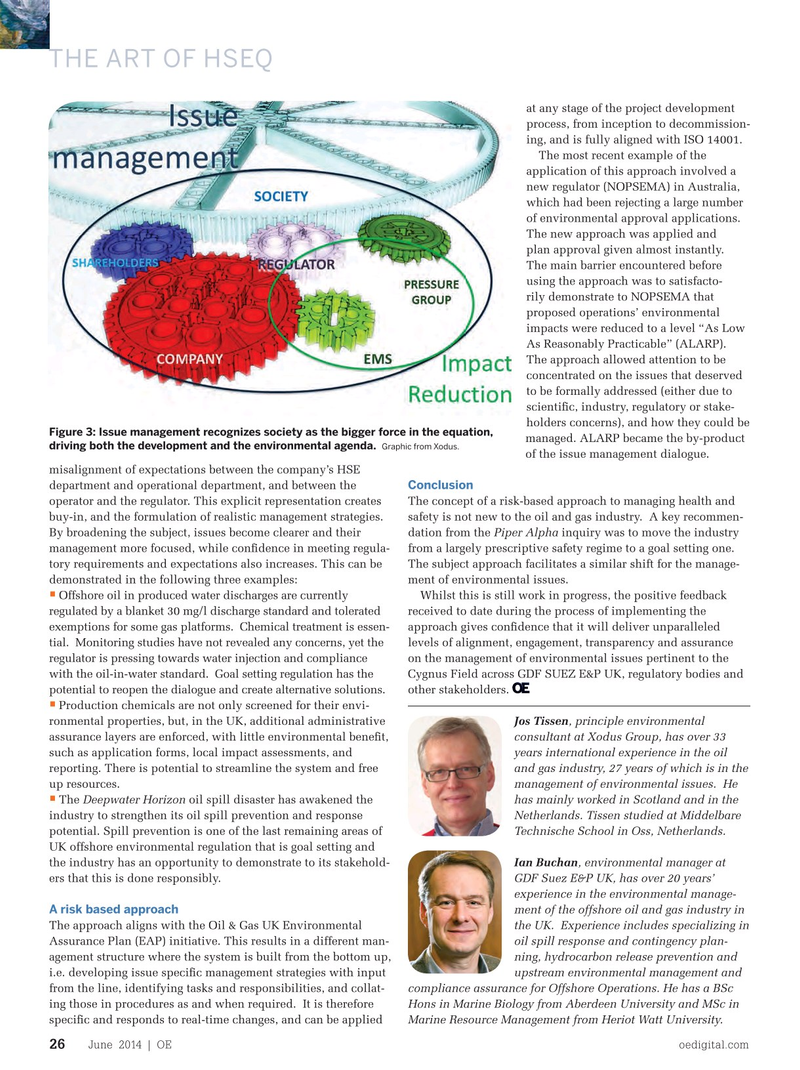
Page 24: of Offshore Engineer Magazine (Jun/Jul 2014)
Read this page in Pdf, Flash or Html5 edition of Jun/Jul 2014 Offshore Engineer Magazine
THE ART OF HSEQ at any stage of the project development process, from inception to decommission- ing, and is fully aligned with ISO 14001.
The most recent example of the application of this approach involved a new regulator (NOPSEMA) in Australia, which had been rejecting a large number of environmental approval applications.
The new approach was applied and plan approval given almost instantly.
The main barrier encountered before using the approach was to satisfacto- rily demonstrate to NOPSEMA that proposed operations’ environmental impacts were reduced to a level “As Low
As Reasonably Practicable” (ALARP).
The approach allowed attention to be concentrated on the issues that deserved to be formally addressed (either due to scienti? c, industry, regulatory or stake- holders concerns), and how they could be
Figure 3: Issue management recognizes society as the bigger force in the equation, managed. ALARP became the by-product driving both the development and the environmental agenda. Graphic from Xodus.
of the issue management dialogue.
misalignment of expectations between the company’s HSE
Conclusion department and operational department, and between the operator and the regulator. This explicit representation creates The concept of a risk-based approach to managing health and buy-in, and the formulation of realistic management strategies. safety is not new to the oil and gas industry. A key recommen-
By broadening the subject, issues become clearer and their dation from the Piper Alpha inquiry was to move the industry management more focused, while con? dence in meeting regula- from a largely prescriptive safety regime to a goal setting one. tory requirements and expectations also increases. This can be The subject approach facilitates a similar shift for the manage- demonstrated in the following three examples: ment of environmental issues.
• Offshore oil in produced water discharges are currently Whilst this is still work in progress, the positive feedback regulated by a blanket 30 mg/l discharge standard and tolerated received to date during the process of implementing the exemptions for some gas platforms. Chemical treatment is essen- approach gives con? dence that it will deliver unparalleled tial. Monitoring studies have not revealed any concerns, yet the levels of alignment, engagement, transparency and assurance regulator is pressing towards water injection and compliance on the management of environmental issues pertinent to the with the oil-in-water standard. Goal setting regulation has the Cygnus Field across GDF SUEZ E&P UK, regulatory bodies and potential to reopen the dialogue and create alternative solutions. other stakeholders.
Production chemicals are not only screened for their envi- • ronmental properties, but, in the UK, additional administrative Jos Tissen, principle environmental assurance layers are enforced, with little environmental bene? t, consultant at Xodus Group, has over 33 such as application forms, local impact assessments, and years international experience in the oil reporting. There is potential to streamline the system and free and gas industry, 27 years of which is in the up resources. management of environmental issues. He
The Deepwater Horizon oil spill disaster has awakened the has mainly worked in Scotland and in the • industry to strengthen its oil spill prevention and response Netherlands. Tissen studied at Middelbare potential. Spill prevention is one of the last remaining areas of Technische School in Oss, Netherlands.
UK offshore environmental regulation that is goal setting and the industry has an opportunity to demonstrate to its stakehold- Ian Buchan, environmental manager at ers that this is done responsibly. GDF Suez E&P UK, has over 20 years’ experience in the environmental manage-
A risk based approach ment of the offshore oil and gas industry in
The approach aligns with the Oil & Gas UK Environmental the UK. Experience includes specializing in
Assurance Plan (EAP) initiative. This results in a different man- oil spill response and contingency plan- agement structure where the system is built from the bottom up, ning, hydrocarbon release prevention and i.e. developing issue speci? c management strategies with input upstream environmental management and from the line, identifying tasks and responsibilities, and collat- compliance assurance for Offshore Operations. He has a BSc ing those in procedures as and when required. It is therefore Hons in Marine Biology from Aberdeen University and MSc in speci? c and responds to real-time changes, and can be applied Marine Resource Management from Heriot Watt University.
June 2014 | OE oedigital.com 26 000_OE0614_HSEQ1_Xodus.indd 26 5/22/14 9:37 PM

 23
23

 25
25